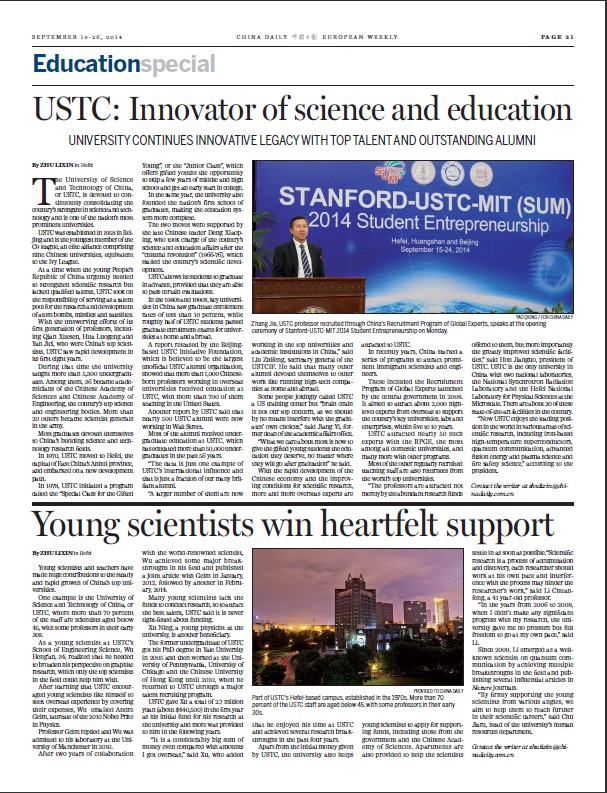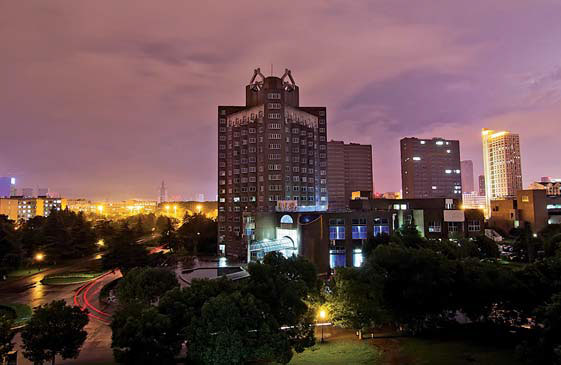9月19日,《China Daily》欧洲版推出中国科大创新整版全彩页报道,称赞中国科大从建校至今在教学和科研方面一直致力于创新。

专版由两篇报道组成,分别是“USTC: Innovator of Science and Education”(《中国科大:科研与教学的创新者》)和“Young Scientists Win Heartfelt Support”(《青年科学家获得衷心支持》)。前者以“顶尖人才、杰出校友与大学不断创新的传统”作为开篇导语,首先介绍了作为精英大学联盟C9联盟中最年轻的高校,中国科大从建校开始就一直在教学和科研各方面致力于创新,比如设立中国第一个少年班、第一个研究生院、鼓励学生提前毕业。中国科大不拘一格培养人才的方式培养了大量的杰出人才,建校初期5300名毕业生中产生了两院院士36名,科学将军20多名。科大最大的非官方校友基金——新创校友基金统计数据表明,海外教授中有1000名毕业自中国科大。而中国科大在科研条件上的不断追求在近年来也吸引了大量海外人才回国效力。“目前中国科大在多个科研领域居于世界领先地位,如高温超导、量子通讯、先进核聚变能、等离子科学和火灾科学等。”《青年科学家获得衷心支持》讲述了青年科学家在中国科大的支持下,获得更多学习和发展机会的例子。如吴恒安在学校支持下在诺奖得主实验室合作研究、徐宁获得高额的科研投入、李传峰在科研积累时期拥有不受干扰的环境踏实成长等等。
专版还以大幅图片新闻的形式报道了当时正在学校开展的斯坦福-中国科大-麻省理工(Stanford-USTC-MIT, 简称SUM)SUM夏令营。该夏令营由引进人才推动,已开展三年,为三所名校之间进行充分合作交流提供了平台。
(新闻中心)
附:报道全文
USTC: Innovator of Science and Education
University continues innovative legacy with top talent and outstanding alumni
The University of Science and Technology of China, or USTC, is devoted to continuously consolidating the country's strengths in science and technology and is one of the nation's most prominent universities.
USTC was established in 1958 in Beijing and is the youngest member of the C9 league, an elite alliance comprising nine Chinese universities, equivalent to the Ivy League.
At a time when the young People's Republic of China urgently needed to strengthen scientific research but lacked qualified talent, USTC took on the responsibility of serving as a talent pool for the research and development of atom bombs, missiles and satellites.
With the unswerving efforts of its first generation of professors, including Qian Xuesen, Hua Luogeng and Yan Jici, who were China's top scientists, USTC saw rapid development in its first eight years.
During that time the university taught more than 5,300 undergraduates. Among them, 36 became academicians of the Chinese Academy of Sciences and Chinese Academy of Engineering, the country's top science and engineering bodies. More than 20 others became scientist generals in the army.
Most graduates devoted themselves to China's budding science and technology research fields.
In 1970, USTC moved to Hefei, the capital of East China's Anhui province, and embarked on a new development path.
In 1978, USTC initiated a program called the "Special Class for the Gifted Young", or the "Junior Class", which offers gifted youths the opportunity to skip a few years of middle and high school and get an early start in college.
In the same year, the university also founded the nation's first school of graduates, making the education system more complete.
The two moves were supported by the late Chinese leader Deng Xiaoping, who took charge of the country's science and education affairs after the "cultural revolution" (1966-76), which stalled the country's scientific development.
USTC allows its students to graduate in advance, provided that they are able to pass certain evaluations.
In the 1980s and 1990s, key universities in China saw graduate enrollment rates of less than 10 percent, while roughly half of USTC students passed graduate enrollment exams for universities at home and abroad.
A report released by the Beijing-based USTC Initiative Foundation, which is believed to be the largest unofficial USTC alumni organization, showed that more than 1,000 Chinese-born professors working in overseas universities received education at USTC, with more than 700 of them teaching in the United States.
Another report by USTC said that nearly 500 USTC alumni were now working in Wall Street.
Most of the alumni received undergraduate education at USTC, which has educated more than 50,000 undergraduates in the past 56 years.
"The data is just one example of USTC's international influence and that is just a fraction of our many brilliant alumni.
"A larger number of them are now working in the top universities and academic institutions in China," said Liu Zhifeng, secretary general of the USTCIF. He said that many other alumni devoted themselves to other work like running high-tech companies at home and abroad.
Some people jokingly called USTC a US training center but "brain drain is not our top concern, as we should by no means interfere with the graduates' own choices," said Jiang Yi, former dean of the academic affairs office.
"What we care about most is how to give the gifted young students the education they deserve, no matter where they will go after graduation" he said.
With the rapid development of the Chinese economy and the improving conditions for scientific research, more and more overseas experts are attracted to USTC.
In recent years, China started a series of programs to attract prominent immigrant scientists and engineers.
These included the Recruitment Program of Global Experts launched by the central government in 2008. It aimed to attract about 2,000 high-level experts from overseas to support the country's key universities, labs and enterprises, within five to 10 years.
USTC attracted nearly 50 such experts with the RPGE, the most among all domestic universities, and many more with other programs.
Most of the other regularly recruited teaching staff are also returnees from the world's top universities.
"The professors are attracted not merely by the abundant research funds offered to them, but more importantly the greatly improved scientific facilities," said Hou Jianguo, president of USTC. USTC is the only university in China with two national laboratories, the National Synchrotron Radiation Laboratory and the Hefei National Laboratory for Physical Sciences at the Microscale. There are about 20 of these state-of-the-art facilities in the country.
"Now USTC enjoys the leading position in the world in various areas of scientific research, including iron-based high-temperature superconductors, quantum communication, advanced fusion energy and plasma science and fire safety science," according to the president.
Young Scientists Win Heartfelt Support
Young scientists and teachers have made huge contributions to the steady and rapid growth of China's top universities.
One example is the University of Science and Technology of China, or USTC, where more than 70 percent of the staff are scientists aged below 45, with some professors in their early 30s.
As a young scientist at USTC's School of Engineering Science, Wu Heng'an, 34, realized that he needed to broaden his perspective on graphite research, which only the top scientists in the field could help him with.

(Part of USTC's Hefei campus, established in the 1970s. More than 70 percent of the USTC staff are aged below 45, with some professors in their early 30s. Provided to China Daily)
After learning that USTC encouraged young scientists like himself to seek overseas experience by covering their expenses, Wu emailed Andre Geim, laureate of the 2010 Nobel Prize in Physics.
Professor Geim replied and Wu was admitted to his laboratory at the University of Manchester in 2010.
After two years of collaboration with the world-renowned scientist, Wu achieved some major breakthroughs in his field and published a joint article with Geim in January 2012, followed by another in February, 2014.
Many young scientists lack the funds to conduct research, so to attract the best talent, USTC said it is never tight-fisted about funding.
Xu Ning, a young physicist at the university, is another beneficiary.
The former undergraduate of USTC got his PhD degree in Yale University in 2005 and then worked at the University of Pennsylvania, University of Chicago and the Chinese University of Hong Kong until 2010, when he returned to USTC through a major talent recruiting program.
USTC gave Xu a total of 2.7 million yuan ($440,500) in the first year as his initial fund for his research at the university and more was provided to him in the following years.
"It is a considerably big sum of money even compared with amounts I got overseas," said Xu, who added that he enjoyed his time at USTC and achieved several research breakthroughs in the past four years.
Apart from the initial money given by USTC, the university also helps young scientists to apply for supporting funds, including those from the government and the Chinese Academy of Sciences. Apartments are also provided to help the scientists settle in as soon as possible."Scientific research is a process of accumulation and discovery, each researcher should work at his own pace, and interference with the process may hinder the researcher's work," said Li Chuanfeng, a 41 year-old professor.
"In the years from 2006 to 2008, when I didn't make any significant progress with my research, the university gave me no pressure but full freedom to go at my own pace," said Li.
Since 2009, Li emerged as a well-known scientist on quantum communication by achieving multiple breakthroughs in the field and publishing several influential articles in Nature journals.
"By firmly supporting the young scientists from various angles, we aim to help them reach further in their scientific careers," said Chu Jiaru, head of the university's human resources department.